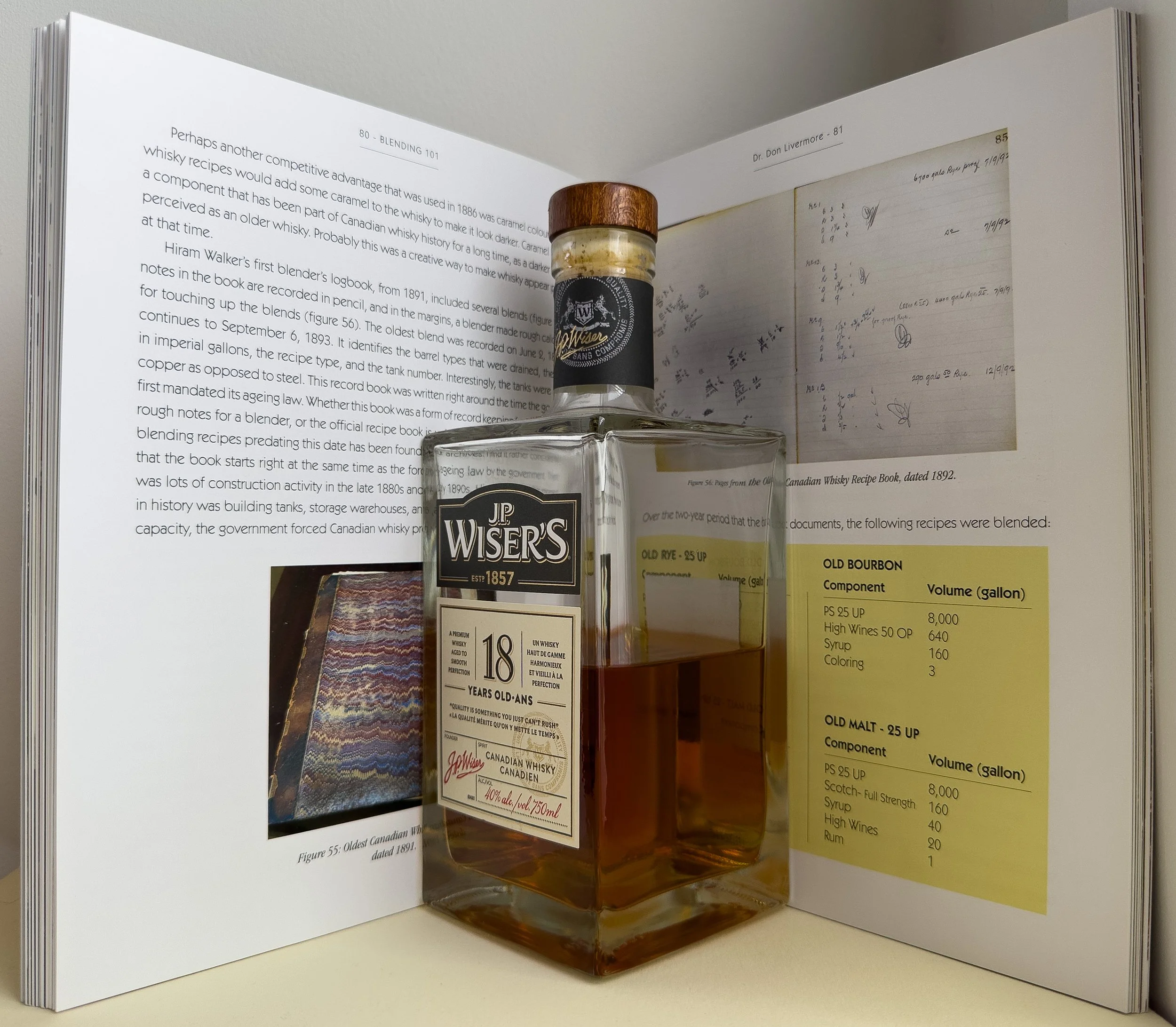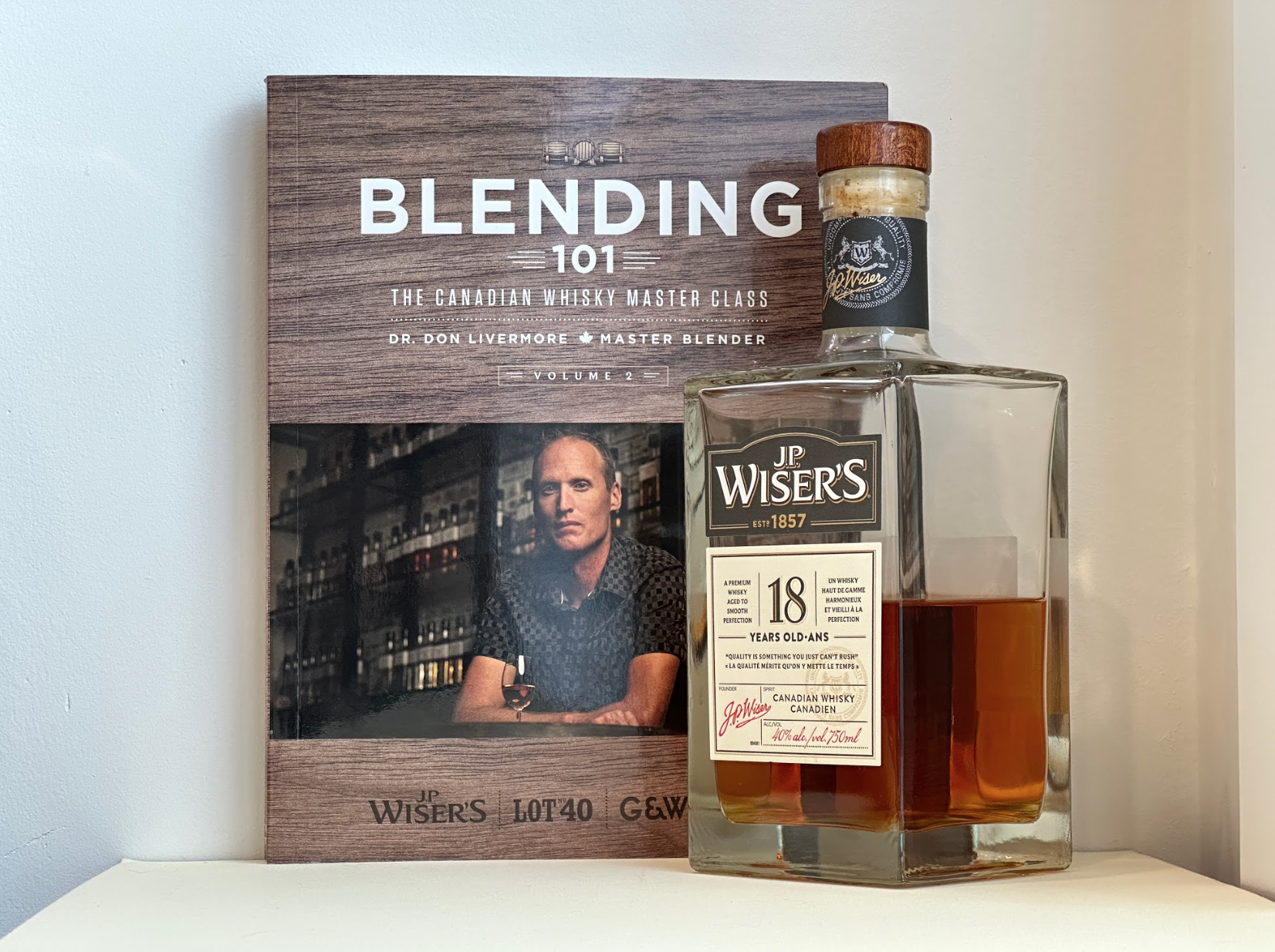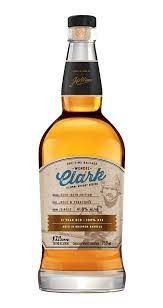JP Wiser’s 18yo
Canadian Whisky & Dr Don’s Book | 40% ABV
Score: 3/10
Disappointing.
TL;DR
Boring whisky your Canadian uncle will love
A Must Read
Blending 101 by Dr. Don Livermore, master blender at Canada’s largest distillery, Hiram Walker, is a must read for the Canadian whisky enthusiast — or any whisky enthusiast. All your questions about Canadian whisky production are answered, including through unapologetic takes on colouring, chill filtration, and the infamous 1/11 rule.
Dr. Don isn’t afraid to go into the technical details as he discusses thermal degradation of cellulose, tannins during the cask burning process, and how the lignin in grain husks is broken down into the building blocks of flavour during mashing and distillation. He does have a PhD in this stuff, after all.
He also dives deep into Canadian whisky blending history, pulling the curtain back on old methods from as far back as the 19th century as he unveils some recipes found in Hiram Walker’s 1891 personal blending notebook.
Needless to say, Mr. Walker’s old blending recipes, of which many were experimental, contain all kinds of shenanigans and provide valuable insight into the history of Canadian whisky. Walker’s Canadian whisky was blended with many components, including bourbon, scotch, rum, brandy, sherry, vermouth, prune wine, bitters, colouring, white sugar, syrup, and even tea!
I’ll wait a minute for you to regain your composure and loosen that white knuckle grip on your pearl strings because this next bit is important. Herein lies the historical basis for the 1/11 rule: it’s a part of our blending history and should be embraced as one of the unique facets of Canadian whisky (with mandated label disclosure, if Aengus has a say).
Dr. Don is an interesting asset for the Canadian whisky industry. As master blender at an institution with a long history that produces more Canadian whisky than any other, he is firmly a member of the old guard in some aspects, but also leans into the current era and appetite for information in that he’s not afraid to interact, talk specifics, and speak his mind. I must say every time I have emailed him, I get a prompt no-nonsense response with all of the details I’m looking for. No fluff or sugarcoating. He is a great ambassador for the brand and those enthusiasts that truly appreciate transparency.
While we love transparency here at Dramface, peeking through the glass doesn’t always provide an image of what we’re looking for in our drink. For example, colouring prevents us from visually enjoying our whisky. It is a practice that only works to sell whisky when the consumer is unaware. It’s understandable that producers who use caramel colouring don’t talk about it, and it’s quite interesting, if not surprising, that Dr. Don tackles it head on.
“From an analytical perspective, no method can detect a difference between caramelized sugars from barrel degradation and caramelized sugars from caramel colouring production.”
— Dr. Don Livermore, Blending 101
I’m not qualified to confirm whether this statement is true, but Dr. Don is dropping bombs and the contrarian in me likes it. However, even assuming there is no chemical difference between caramelized barrel sugars and added caramel colourant, I don’t think many would say they wanted extra added to their whisky after the fact.
Dr. Livermore goes on to clearly state that he colours his whisky because he wants to avoid a situation where two bottles of different hue end up on the shelf side by side. It’s there in the text, ladies and gentlemen, with no apologies. The reality we have to understand is that the number of uneducated consumers for which a colour difference may raise eyebrows vastly outweighs those of us who know enough to expect some batch variation. Therefore, any whisky from Hiram Walker made in more than one batch will always be coloured. It’s better for their business.
The sensory panel at Hiram Walker is a carefully selected and trained group of individuals that evaluate blends against standard samples kept as a reference for the desired smell and taste profiles. It is this panel that gives the green light for bottling blended batches when they have achieved the desired characteristics of any given brand or product line produced by the distillery.
According to his book, the sensory panel at Hiram Walker can’t tell the difference between chill filtered and un-chill-filtered whisky. Dr. Don challenges other brands to release chill-filtered and un-chill-filtered whisky from the same batch so that we can all be the judge. Maybe there are some that have tested this already in a repeatable fashion, if so please let me know.
“Our philosophy is that we would rather have a clear product, which appeals to the mass of the population, than rather field complaints about haze or flocculation for the sake of the very few people who think they can tell the difference.”
— Dr. Don Livermore, Blending 101
To add a bit of context that may help explain the panel’s observation: every whisky at Hiram Walker is born by first passing through a massive beer still (or column still, in other parlances). It’s a totally different process from pot distilling and can arguably strip out many of the components that are affected by chill filtration in the first place, especially when distilling to high alcoholic strength. What is left after column distillation that can still cloud up a glass is maybe better answered by someone like our Tyree, but for the sake of Dr. Don’s argument, I’ll assume that column distillation makes chill filtration less impactful on the final product. Part of the joy of Canadian whisky is that every distillery does things differently!
Review
JP Wiser’s 18yo, Canadian Whisky, 40% ABV
CAD$85
As discussed in a previous review, the traditional Canadian whisky style is a blended style mostly made up of column-distilled light corn whisky called base whisky. At the Hiram Walker distillery in Windsor, Ontario, this means column distilling corn mash to 94.5% ABV, just a hair below what could be considered a neutral spirit. For this reason, it doesn’t really matter what grain is used; in the eastern portion of Canada, the most economical grain to use, corn, is used for this light base whisky. In western parts of Canada, rye, or wheat, is commonly used to make this type of base whisky.
This 18-year-old Canadian whisky is indeed bottled from 100% light corn base whisky which has passed through multiple column stills (beer still, extraction column, rectification column) to achieve the target alcoholic strength of 94.5% ABV. It is diluted to 76% ABV for filling in barrels that started out as ex-bourbon but have likely been filled and refilled many times.*
*At Hiram Walker’s automated filling station, bungs are drilled and barrel contents are extracted six at a time without human intervention. If the machines suck out the expected amount of whisky, it is presumed the barrels are structurally intact. Intact barrels are refilled automatically within minutes and sent back to the 1.6 million barrel warehouse complex.
Nose
Sweet nose with green apple, caramel, Werther’s Original, and a bit of rum. Pine forest, acetone, smooth vanilla creme, and a mere suggestion of chocolate.
Palate
A thin, watery, bitter disappointment in the mouth following the pleasant, classically Canadian nose. Milky rum and bitter oak with orange and cloves, and a strong astringency that hits the sides of the tongue.
The Dregs
A 3/10 may seem a bit harsh, as there are no glaring faults or unpleasantnesses that would normally be required to merit such a low score (except for the lacklustre mouth experience). But I considered and mulled, and it’s simply too boring for a four. This is a disappointing whisky.
The market for this bottle is the employee or family member of a Canadian whisky drinker who wants to buy their boss or uncle a fancified version of what they normally buy on repeat. This is all about getting ethanol into the bloodstream. Those who drink spirits for the taste experience are certainly in the minority, and we shouldn't forget that when judging products that clearly aren’t meant for us.
I don’t take any pleasure in doling out a low score to such an established and reputable Canadian brand that, in general, produces good products. I’m doing it out of love for Canadian whisky, and what could be.
I love Dr. Livermore’s book. It’s honest and transparent, and tells me exactly where his head is at. There is a reason for this whisky to exist; it’s just not for enthusiasts to drink.
Score: 3/10
Dr Don’s Blending 101
Having evaluated Wiser’s 18, I’ve come to the conclusion that it is something of a blank canvas. It is an outline for a painting that is waiting for the details to be applied however the master blender wishes. Although lacking in character, it cannot be denied that it is a quality base from which to start and build something. As a bonus to this review, I’ve taken the liberty of going one step further to see if I can complete the picture with some rudimentary home blending. I haven’t scored these, but all represent significant and interesting improvements on the base whisky.
Home Blend 1/4: Ontario–Alberta Blend
70% Wiser’s 18yo
30% Whistle Pig 10yo Rye
Nose
Apple, dill, caraway, pine, tropical fruit.
Palate
The character is much improved with the addition of some rye; I get dill, cloves, and caraway as the Whistle Pig shines through. Lighter and brighter than the rye on its own with orange, cherry, ginger, and tropical fruit juice concentrate.
Home Blend 2/4: All-Ontario Blend
70% Wiser’s 18yo
30% Wendel Clark Rye
Nose
A bit shy on the nose: muted rye, nutmeg, and caraway.
Palate
Dill, Pine-Sol, nutmeg. Less impressive as a blend as the Wendel Clark Rye doesn’t have the oomph to push J.P. Wiser aside. A bit thin, with hot pepper, spiced apple, and dried cranberry.
Home Blend 3/4: Transatlantic Blended Grain
70% Wiser’s 18yo
30% Clynelish 14yo Single Malt
Nose
Red fruits and savoury notes come through with roasted vegetables.
Palate
Elegant and fresh; the corn whisky base gives the single malt room to spread out, stretching its legs with more separation between notes. Ripe and juicy fruits, red apple, candle wax, berries, vanilla, allspice, and flaky pastry.
Home Blend 4/4: NATO Bourbon
70% Wiser’s 18yo
15% Whistle Pig 10yo Rye
15% Clynelish 14yo Single Malt
Nose
Understated with some generic rye spice.
Palate
Red fruits, apple, smooth toffee, and lemon; floral with bergamot and lavender. Somewhat confused and not cohesive.
The Dregs
This home blending business may not be of much value to the reader, but it was a tremendous learning experience for myself. It is interesting how the light corn base whisky provides space for more flavorful whiskies to decompress. Sometimes you get a diluted version of what you started out with, sometimes it is something entirely new. The more strongly flavoured Whistle Pig rye gives a large dose of rye character even when small amounts are added to the base whisky; the Whistle Pig blend and the Clynelish blend are the two standouts here.
Even just a small home experiment like this has given me a deeper respect for blenders and the blended whiskies they create, and now I’m thinking I’ll need to keep this Wiser’s 18 around. It may be a useful tool when it comes to dissecting other whiskies.
Tried this? Share your thoughts in the comments below. AMc
-
Dramface is free.
Its fierce independence and community-focused content is funded by that same community. We don’t do ads, sponsorships or paid-for content. If you like what we do you can support us by becoming a Dramface member for the price of a magazine.
However, if you’ve found a particular article valuable, you also have the option to make a direct donation to the writer, here: buy me a dram - you’d make their day. Thank you.
For more on Dramface and our funding read our about page here.



































